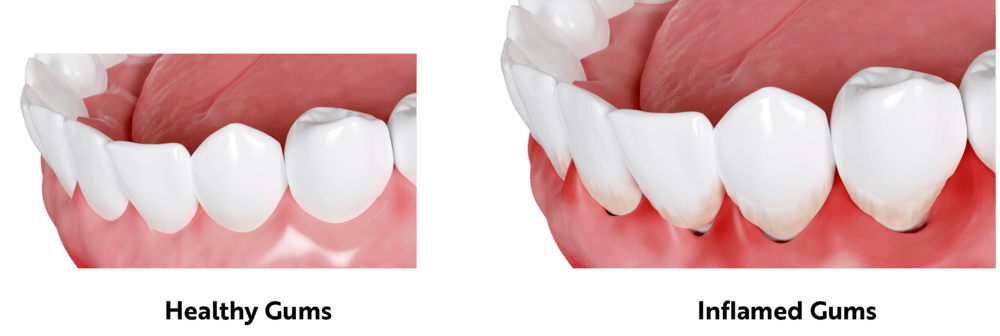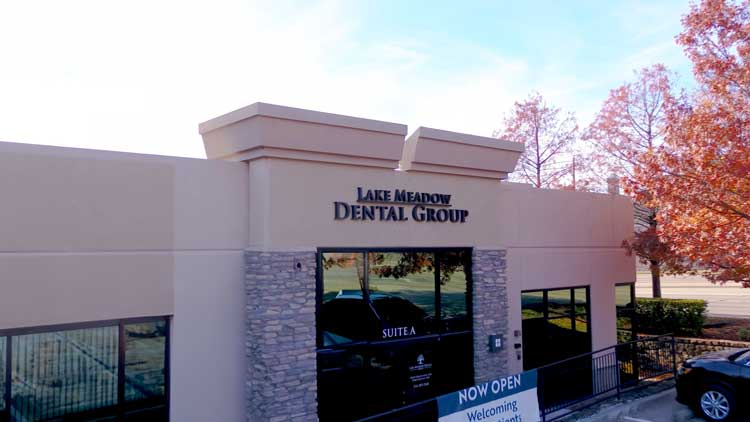Gum disease is caused by a buildup of plaque, a sticky form of bacteria that forms on the teeth below the gum line. If the plaque is not removed by flossing, brushing, and regular dental checkups, it will create toxins that can damage the gums. Periodontal disease has two stages – Gingivitis and Periodontitis.
Gingivitis – This is the early stage of gum disease. Gum swelling develops producing open pockets between the gums and the tooth. The gums become red, swollen, and bleed easily. With intervention, the disease is treatable at this stage and can often be eliminated with maintenance of daily brushing and flossing.
Periodontitis – If left untreated, Gingivitis will advance to Periodontitis. Gums pull away from the teeth, exposing the roots, and eventually causing bone loss. The gums and bone that support the teeth will become seriously and irreversibly damaged. Gums infected with periodontitis can cause teeth to become loose, fall out, or need to be removed by a dentist. Chronic gum disease is associated with heart disease, diabetes and other chronic illness.

– Smoking or using chewing tobacco
– Diabetes
– Certain types of medication such as steroids, anti-epilepsy drugs, cancer therapy drugs, calcium channel blockers, and oral contraceptives
– Bridges that no longer fit properly
– Crooked teeth
– Old fillings
– Pregnancy
– Gums that bleed easily
– Red, swollen, tender gums
– Gums that have pulled away from the teeth
– Persistent bad breath or bad taste
– Pus between your teeth and gums
– Permanent teeth that are loose or separating
– Any change in the way your teeth fit together when you bite
– Any change in the fit of partial dentures
Practicing good oral hygiene at home can significantly reduce your chances of ever getting gum disease and are important for maintaining your health and the health of your smile.
– Brush regularly at least twice daily
– Clean and floss between your teeth daily
– Eat a nutritious diet
– Avoid tobacco products
– Schedule regular dental checkups, cleanings and periodontal exams
The first line of defense against gum disease is a unique type of cleaning called “scaling and root planing.” In this procedure, an ultrasonic cleaning device is used to remove plaque and tartar from your teeth where regular cleaning devices cannot reach – under the gum line, on the tooth, and around the root. Then, the rough surface of the tooth and the root are smoothed out or planed, providing a healthy, clean surface that makes it easier for the gum tissue to reattach to the tooth.
Scaling and root planing may be the only treatment you need if you treat gum disease before it becomes severe. However, as with any dental procedure, after-care is vital. To keep your teeth in good shape and avoid future occurrences of gum disease, you must brush and floss daily, eat a healthy diet, avoid tobacco use, and have regular dental checkups. Even after a successful scaling and root planing, if you do not care for your teeth properly, you are likely to develop gum disease again.
If the tissue or bone surrounding your teeth is too damaged to be repaired with non-surgical treatment, several surgical procedures are available to treat severe damage and to restore a healthy smile. Following is a list of common types of periodontal surgery. We will recommend the procedure that is best suited to the condition of your teeth and gums.
Pocket Depth Reduction
In a healthy mouth, the teeth are firmly surrounded by gum tissue and securely supported by the bones of the jaw. Periodontal disease damages these tissues and bones, leaving open spaces around the teeth that we call pockets. The larger these pockets are, the easier it is for bacteria to collect inside them, leading to more damage over time. Eventually the supportive structure degrades to the point that the tooth either falls out or needs to be removed.
During pocket reduction procedures, also known as “flap surgery,” the gum tissue is folded back to remove the bacteria hiding underneath along with any hardened plaque and tartar that have collected. Any tissue that is too damaged to survive is also removed. Healthy tissue is stitched back into place. The gums can reattach to the teeth now that the tooth and root are free of bacteria, plaque, and tartar, and the pockets have been reduced.
Regeneration
When the bone and tissue supporting the teeth have been lost due to severe gum disease, these areas can be restored with a regeneration procedure. The gum tissue is folded back to remove bacteria, plaque and tartar. Depending on the situation, a bone graft may be performed to stimulate new bone growth. A special kind of protein may be applied to stimulate tissue growth to repair the areas that have been destroyed by the disease.
Soft-Tissue Graft
A frequent symptom of gum disease is gum recession, also called gingival recession. As the gums recede, more of the roots are revealed. This can make teeth appear longer and can also create sensitivity to hot or cold liquids or food. It also exposes the tooth to increased damage from gum disease, as bacteria, plaque, and tartar attack the surface of the tooth and the root.
During a soft-tissue graft, tissue from the top of the mouth or another source is stitched to the gum area, covering the roots and restoring the gum line to its original, healthy location. This procedure can also be performed for cosmetic reasons.
Need to have your teeth or gums evaluated by a dentist? Call Lake Meadow Dental Group or schedule an appointment online.
For more information on gum disease – scaling and root planning, read our blog on Why Are My Gums Swollen.

Our team has delivered outstanding dental care in Lake Highlands for over 45 years. We are committed to providing our community with safe, gentle, high-quality dental care.
Should you have any questions or concerns regarding your dental care, we are more than happy to discuss how you can achieve a beautiful and healthy smile.
As a top dentist in Lake Highlands, we have helped hundreds of families achieve their oral health goals and are eager to help you and your family do the same.
Lake Meadow Dental Group © 2025 | All Rights Reserved